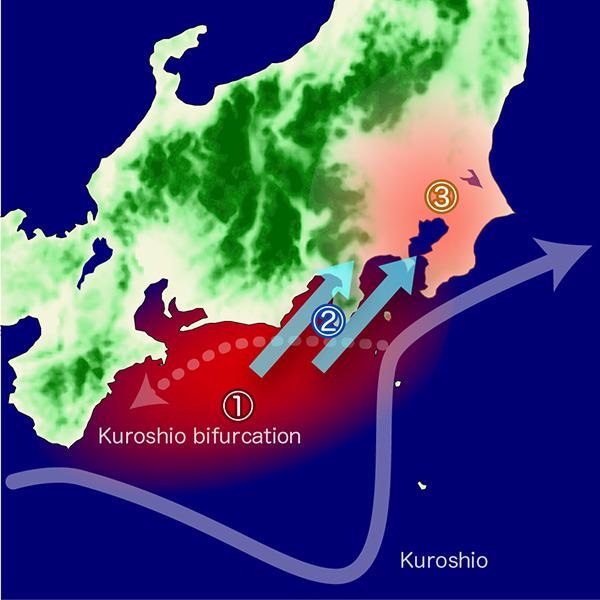Mar 31 2021
According to a new study performed by an international research team, 40 million individuals living in Japan’s Kanto region, which also comprises Tokyo, might blame a meandering ocean current for the rising hot and humid summers.
 A Kuroshio meander causes an increase in water temperature/evaporation which is then blown towards Kanto by summer south winds. The greenhouse effect of water vapor then causes an increase in the air temperature as illustrated above. Image Credit: ©️ Tohoku University.
A Kuroshio meander causes an increase in water temperature/evaporation which is then blown towards Kanto by summer south winds. The greenhouse effect of water vapor then causes an increase in the air temperature as illustrated above. Image Credit: ©️ Tohoku University.
The Kuroshio Current travels toward the north direction and brings warm water from the tropics to the southern coast of Japan. But since 2017, this current has deviated from its regular route, turning toward the south direction before resuming in the north direction.
Researchers have now discovered that the 'large meander' accounts for the uptick in temperature and humidity.
The investigators from Tohoku University based in Japan and the University of Hawaii based in the United States have published their findings online in the Journal of Climate—a journal of the American Meteorological Society—on February 1st, 2021.
In recent years, it has become clear that the ocean influences climate. Our study shows that the Kuroshio influences the regional climate—especially through the greenhouse effect of water vapor, contributing to significantly warmer temperatures.
Shusaku Sugimoto, Study First Author and Associate Professor of Geophysics, Graduate School of Science, Tohoku University
For this study, the investigators used the satellite information from the National Aeronautics and Space Administration (NASA) and also used the information from the Automated Meteorological Data Acquisition System stations managed by the Japan Meteorological Agency to assess 18 summer seasons since 2003.
The final but massive meander summer lasted for a year between 2004 and 2005 before continuing again in 2017.
Managing other climatic events, like storms, and accounting for global warming trends, the team evaluated the variations in summers during standard summer seasons, including summers in which the path of the Kuroshio Current took a large meander.
We found that the surface air temperature in the Kanto district increased by about 0.6 degrees Celsius as a result of the Kuroshio large meander. As a mechanism of the warming, we discovered that the Kuroshio large meander increases evaporation and the water vapor flowing into the Kanto region, leading to a hot summer through a local greenhouse effect.
Shusaku Sugimoto, Study First Author and Associate Professor of Geophysics, Graduate School of Science, Tohoku University
The researchers used Thom’s index—an extensively used standard of human discomfort based on humidity and temperature—and observed that large meander summers led to 13.1 days, causing discomfort to a majority of the people. This is an increase of 160% over the 8.1 days of discomfort experienced during non-large meander summers.
This is a result that affects the lives of many people. Our analysis showed the Kuroshio path state is responsible for the climatic comfort of living in Tokyo, Japan, and our approach is also applicable in other coastal cities worldwide.
Shusaku Sugimoto, Study First Author and Associate Professor of Geophysics, Graduate School of Science, Tohoku University
Sugimoto added that the team has planned to apply their study to enhance climate as well as local weather forecasts, so that individuals would be better prepared to face more humidity and higher temperatures.
“The results of this research are expected to contribute to the reduction of heatstroke risk and the formulation of climate change adaptation plans. This finding detects the influence of the ocean on regional climate, and we hope that it will contribute to the improvement of weather and seasonal forecasts,” concluded Sugimoto.
Journal Reference:
Sugimoto, S., et al. (2021) Local Atmospheric Response to the Kuroshio Large Meander Path in Summer and Its Remote Influence on the Climate of Japan. Journal of Climate. doi.org/10.1175/JCLI-D-20-0387.1.